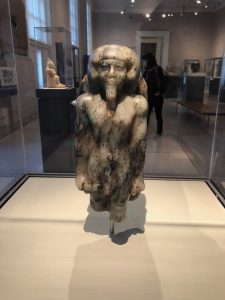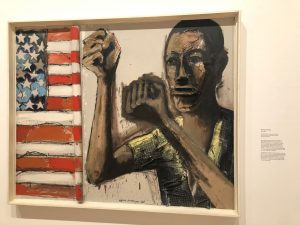Part 1: Art from the Ancient World


The first exhibition I went to was artwork from Ancient Egypt. This exhibit mostly had statues/statues and sculptures of different sizes. The art piece that stuck out to me is known as Statuette of a Male Deity (Old Kingdom, Dynasty 5, circa 2500-2350 B.C.E). This medium-sized statue stuck out to me most because of the marble-looking detail. Marble is my favorite type of print. This male statuette is light grey with black spots making it look like a marble print. The figure has a large wig and unusual clothing, which includes a penis sheath attached to a tied belt. This indicates that he is a deity. The identity of the statuette is undetermined. It’s known to either be done for either a temple or king’s tomb. This statue was the result of a royal workshop. It’s made of a very hard stone known as gneiss, a metamorphic rock. Its structure is a god’s strong, youthful body with muscles by the upper arms and chest, which reflects the ideal of the male form in Old Kingdom sculpture. The deity is in a standing position. He has a conventional pose, with his left leg advanced, hands by sides, chipped knife clasped in right hand, and his other hand is closed. His wig is plain & covers almost his whole forehead, long beard by his chin, has eyes with the eyelids a little closed, wide nose, and thick lips. The figure is standing against round-topped, plain, upright stone column that looks like a gravestone (stela). The condition of this statuette is the body is only to the knees, his right hand is broken, and his left elbow is chipped.
Part 2: Art from Soul of a Nation

The next exhibition I went to was Soul of a Nation, which showed art in the age of black power in the 20th century. These works of art were made between 1958-1983 during the fight for liberation, where African Americans experienced discrimination and racial violence at the hands of white citizens and the state. This area had many paintings on canvases that portrayed a lot of meaning. Specifically, in the artists of New York, the artwork that stood out to me was was by Benny Andrews, Did the Bear Sit Under a Tree?, 1969. This oil painting has an image of an African American man wearing a black and yellow boxed pattern shirt holding up his fists to the red, white, and blue with star drawings American flag, which is made of a sheet of rolled-up rough-looking fabric. The figure is a skinny African American man, has a straight face, and his mouth is made of a zipper. His shirt also appears to be made of a fabric because it stuck out of the painting. The texture used is a burlap bagging sack. Black paint was used for shadowing by his arms, shirt, and face. The painter colored outside the lines and has splatters of paint by the arms and the face. I chose this art piece because the 3D from the roll from the flag and his shirt stood out to me, it’s a painting from my hometown, and it had an important figurative meaning from the looks of it. This painting relates to this exhibition because of the use of the flag and the fist symbolizes Black solidarity. This work reflected the Civil Rights protests of the 1960s and it portrays “a black person who is shaking his fist at the very thing that is supposed to be protecting him [the flag] and that he’s operating under” (Andrews). This painting really showed me what the blacks were going through during that era because of the detailed unhappy expression on the figure’s face. They couldn’t rely on the American flag to protect them.

